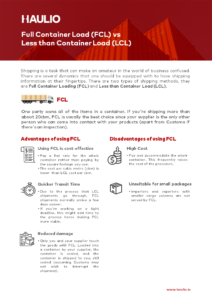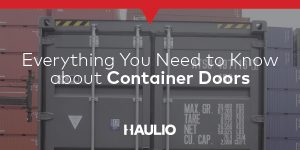Full Container Load (FCL) vs Less than Container Load (LCL)
Shipping is a task that can make an amateur in the world of business confused. There are several dynamics that one should be equipped with to have shipping information at their fingertips.
First, there are two types of shipping methods, namely Full Container Load (FCL) and Less than Container Load (LCL) methods.
The key difference between FCL and LCL is that in an LCL shipment, the buyer shares space in a container, while in an FCL agreement, the buyer rents the entire container space.
Full Container Load (FCL)
In Full Container Load (FCL), one party owns all of the items in a container. Instead of paying for a portion of a container, you pay for the whole container. If you’re shipping more than about 20cbm, FCL is usually the best choice since your supplier is the only other person who can come into contact with your products (apart from Customs if there’s an inspection).
Advantages of FCL
1. Using FCL is Cost-Effective
2. Reduced Damage
Only you and your supplier touch the goods with FCL, lowering the risk of harm. FCL shipments are loaded into a container by your supplier, the container is sealed, and the container is shipped to you, still sealed (assuming Customs may not wish to interrupt the shipment). This reduces the chances of goods being damaged while in transit. So, if you have a lot of delicate items and aren’t sure which tool to use, we recommend paying a little extra for a complete container.
3. Quicker Transit Time
Due to the process that LCL shipments go through, FCL shipments normally arrive a few days sooner than LCL shipments. Since LCL shipments combine the products of many people, there are additional steps in the process on both sides where the goods must be loaded and unloaded. If you’re working on a tight deadline, this might add time to the process hence making FCL more viable.
Disadvantages of FCL
1. Higher Costs
2. Unsuitable for Small Packages
Importers and exporters with smaller cargo volumes are not served by FCL.
When should you consider using FCL?
1. Regular Shipments
2. Speed
When a supplier needs the goods to take a shorter time to be shipped, FCL is ideal. Since the containers are unloaded from the vessel and transported to the final destination, the overall transit period is normally shorter than for LCL.
3. Nature of Goods
It is paramount to identify the nature of goods you intend to ship since goods are handled differently in FCL and LCL. Since the container travels a direct route with a single consignee, there is a reduced chance of the cargo being damaged, stolen, or lost. FCL is more viable in handling delicate goods whose worth is high.
Less than Container Load (LCL)
Advantages of LCL
1. Low Costs
When you ship your products through LCL, you’ll split the freight costs with all of the suppliers with whom you’ll be sharing the container.
2. Low Inventory
LCL reduces the costs of maintaining a large inventory of products by allowing smaller quantities to be shipped more frequently.
Disadvantages of LCL
First, shipments by LCL can be substantially more costly per cubic meter than shipments by FCL. Secondly, other LCL products inside a container can be delayed due to Customs issues. Lastly, LCL shipments need further handling, which can increase the risk of injury.
When should you consider using LCL?
1. Shipment Volume
2. Freight Costs
It is cheaper to split freight costs while using LCL than using a whole container which may have a lot of wasted empty space remaining, for no reason.
3. Split Shipments
In the event a supplier intends to split a shipment, LCL is recommended. If you’re shipping to multiple Amazon FBA locations or 3PLs, the LCL service allows you to divide the shipment instead of sending multiple complete containers. Also, depending on the overall number, LCL could be a better choice if the shipments are going to several addresses that are far apart. The load can be split up so that various ports can be used depending on where the shipment is being delivered.
Download the Infographic
Would you like the above information in a nice infographic? Download it below!

Keen to Find Out More?
Get in touch via the form below and we’ll get back to you shortly!






